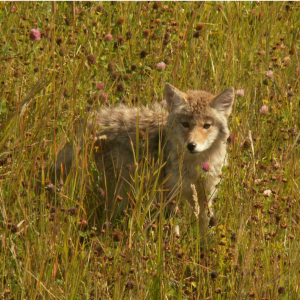A. David M. Latham, M. Cecilia Latham, Mark S. Boyce, and Stan Boutin
Department of Biological Sciences, University of Alberta
June 2011
Abstract
Coyote (Canis latrans) range extension has been generally associated with the expanding frontiers of human activity and footprint; however, little is known about coyote expansion into the boreal forest, their interactions with sympatric wolves (C. lupus) or their potential role as predators of calves of threatened woodland caribou (Rangifer tarandus caribou). We assessed coyote habitat selection, diet, and spatiotemporal relationships with caribou, wolves, and industry in a caribou range in northeastern Alberta, Canada. Our results support the hypothesis that industrial footprint has facilitated coyote range expansion into caribou range.
Coyotes and wolves showed resource partitioning, with coyotes specializing on small prey and wolves specializing on moose (Alces alces), white-tailed deer (Odocoileus virginianus), and beaver (Castor canadensis). Deer was also common in coyote diet, suggesting this prey species might be contributing to the northward range expansion of coyotes. During the caribou calving season, wolves avoided caribou-preferred habitats (i.e., bogs and fens); however, 2 packs diverged from this pattern by showing selection for fens. Conversely, the 4 coyotes we assessed showed selection for bogs or fens. These results suggest both canid predators spend time foraging in areas frequented by caribou. However, scat analyses revealed that caribou were rare in coyote diet, a phenomenon also reported for wolves.
Because even limited predation on caribou adults and calves can have a significant impact on caribou populations, we recommend that management actions to conserve caribou should focus on alternative predators in addition to wolves.

# 914451